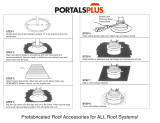4
APPLICATION
These instructions apply to the
Simpson Dura-Vent DirectVent Pro
4”x6-5/8” and 5”x8” systems. This
venting system, in combination
with the gas appliance, has been
tested and listed as a decorative gas
appliance system or as a direct vent
heater system by a major testing
agency such as UL, AGA, CGA,
OMNI, or Warnock Hersey. Check
the manufacturer’s rating plate and
instruction manual to conrm that the
Simpson Dura-Vent Direct Vent is
approved for use on the brand name
appliance you have selected.
IMPORTANT
Read all instructions carefully before
starting the installation. Failure to follow
these instructions may create a re or
other safety hazard and will void the
warranty. Check with the appliance
manufacturer’s installation
instructions for specic venting
and clearance to combustible
requirements, which may vary from
one appliance to another. Be sure
to comply with minimum or maximum
distances of vertical or horizontal
runs as prescribed in the appliance
manufacturer’s installation instructions.
WARNING
• Always maintain required clearances
(air spaces) to nearby combustibles
to prevent a re hazard. Do not ll
air spaces with insulation. Be sure to
check the appliance manufacturer’s
installation instructions for minimum
clearance requirements between
the outer walls of the vent pipe and
nearby combustible surfaces. Be
sure to check the vent termination
clearance requirements from decks,
windows, softs, gas regulators, air
supply inlets, and public walkways,
as specied in these installation
instructions and local building codes.
• The gas appliance and vent system
must be vented directly to the outside
of the building, and never be attached
to a chimney serving a separate solid
fuel or gas-burning appliance. Each
direct vent gas appliance must use its
own separate vent system. Common
vent systems are prohibited.
SAFETY PRECAUTIONS
FOR THE INSTALLER
• Wear gloves and safety glasses for
protection.
• Exercise extreme caution when
using ladders or on roof tops.
• Be aware of electrical wiring
locations in walls and ceilings.
INSTALLATION
PRECAUTIONS
The Simpson Dura-Vent DirectVent
Pro is an engineered product that has
been designed and tested for use with
approved direct vent gas appliances
only. The Simpson Dura-Vent
warranty will be voided, and serious
re, health, or other safety hazards
may result from any of the following
actions:
• Installation of any damaged
DirectVent Pro component.
• Unauthorized modication of the
DirectVent Pro System






















